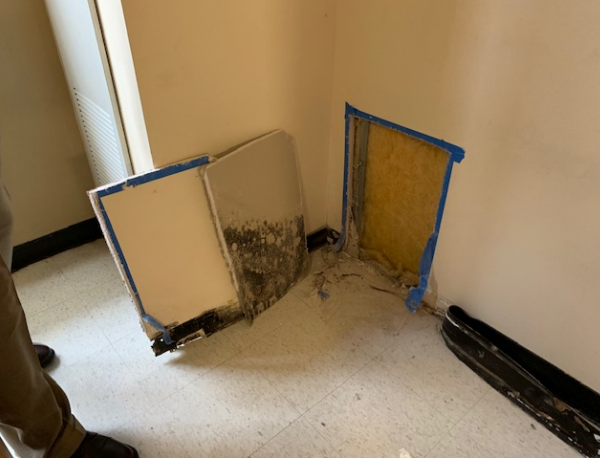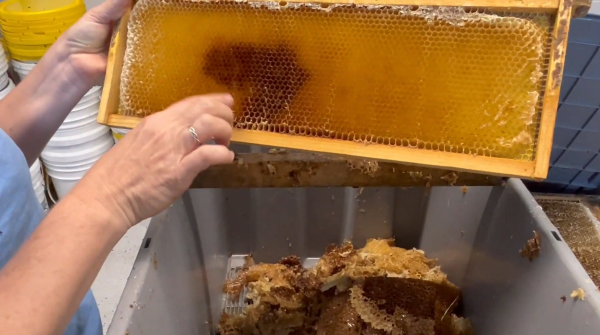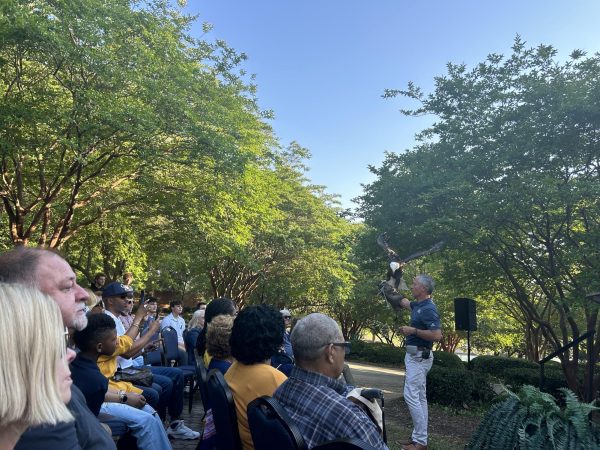Kennedy Hall’s history reveals mold issues
February 22, 2019
The Arrowood Environmental Group conducted multiple tests at Kennedy Hall and revealed a long history of mold problems that occurred for at least 26 months and also identified the species growing in student living facility spaces.
According to maintenance records and the report by Arrowood, the mold problem has a history that extends at least 26 months prior to the shutting down of Kennedy Hall.
According to maintenance reports, there were a total of 160 work orders placed in which mold samples were taken. Of all the 160 recorded cases, only one was severe enough that it required the movement of a student. Each time there was a minor issue with mold, the staff would disinfect or remove the surface the mold was on Peter Blutreich, executive director of university housing, said.
In addition to these past occurrences, Kennedy Hall has been running as a residential hall since 1998. The last major construction event for Kennedy was eight years ago which was a boiler change, Blutriech said.
12 rooms inspected for mold
On Jan. 2, Arrowood Environmental Group conducted a test in Georgia Southern’s Kennedy Hall to investigate concerns regarding extensive mold growth inside the walls of Kennedy Hall after repeated reported issues with moisture and humidity according to the report.
According to the report, there was a total of 12 rooms evaluated for mold spores and growth. The 12 rooms were examined for aerial spores collected and sent to a laboratory. According to the report, the Heating, ventilation and air conditioning system was off at the time of the site inspection, and it was clear from visible mold growth observed along with staff’s historical documentation that the HVAC system is inadequate in dehumidification of the building and its replacement should be considered critical to the resolution of the indoor mold issues experienced within the building.
Cause of Mold Growth
According to the report, Kennedy Hall uses a HVAC system called a Chill Water system in order to cool the building. According to How Stuff Works.com, a chilled-water system is where the entire air conditioner unit is installed on the roof or behind the building. The unit chills the water then sends the water around the building to air handlers. The water then acts like evaporator coils in a standard air conditioning unit. If it’s well-insulated, there’s no practical distance limitation to the length of a chilled-water pipe which is why it is ideal for large buildings.
According to the study, the staff reported that the system of pipes that move the cold water through the walls slowly break down over time resulting in condensation building in the interior walls. Also reported was the fact that the building had “ongoing high relative humidity levels,” and long term moisture.
As a result of the humidity and water condensation, mold growth issues within the building have been sprouting for at least 26 months. According to the report, this combination of conditions allowed for what staff called “Mold Blooms” or surface based mold growth that would require surfaces to be disinfected and removed as procedure called for it.
It is nearly impossible to identify mold species from sight alone, Health Service’s Medical Director and Staff Physician Brian DeLoach, Ph.D., said. According to the study, the inspection group sent off the collected mold spores to a laboratory in order to discover which kinds of species were inhabiting the rooms.
According to the report, the predominant species found in the air samples were Aspergillus/Penicillium, which is an opportunistic species that is associated with fungal lung infections and typically appears elevated during initial high moisture periods within buildings.
According to the report, Stachybotrys was also one of the most recurring species found, which is more commonly known as “black mold”.
Another species that did not compare to the amount of Aspergillus/Penicillium and Stachybotrys was the Cladosporium Spore according to the report. This spore was in a majority of the rooms but not in any sense comparable to the previous two spores listed.
Other mold findings according to the report:
- Aureobasidium
- Curvularia
- Chaetomium
- Torula
- Pestalotia
- Pithomyces
- Eppicoccum
- Nigrospora
- Smuts
- Periconia
- Myxomycetes
These spore types were not of great occurrence or in every room, but they were present nonetheless.
Mold Health Effects
DeLoach said, “It is important to understand that the term “black mold” or “toxic black mold” can be misleading.”
DeLoach said that in the medical/scientific community, the term “toxic black mold” is applied specifically to the fungus Stachybotrys, but other fungi produce dark pigments and can look dark or black when viewed on an environmental surface.”
Stachybotrys produces toxins labeled as a Mycotoxins which are the bi-product that certain fungi produce.
Although a toxin-producing fungus may be present in any given environment, its presence alone does not ensure that it is producing or will produce mycotoxins DeLoach said. Despite a portion of people being more likely to be affected by mold spores, most descriptions of mycotoxicosis in humans are derived from the ingestion of moldy foods. Also, not all black molds produce mycotoxins.
According to the report, all fungal spores whether viable or non-viable are allergens. Some individuals who are immunocompromised are at an increased risk of opportunistic infections with fungi due to their weakened immune system.
DeLoach said which conditions may cause an individual to be immunocompromised include, but are not limited to:
- HIV syndrome
- Those on immunosuppressant medical therapy or cancer chemotherapy
- Persons with abnormally low white blood cell counts (neutropenia)
- Patients with poorly controlled diabetes mellitus
Exposure to such significant amounts of fungal aerosols is unlikely to occur outside of an occupational setting, but there is no set “safe” levels of airborne mold spores according to the study. DeLoach said “Just because fungal growth is seen or found does not mean that it is causing or will cause health effects.”
University Actions
Currently the university is sending in a group to study the extent of the mold.
“We’ve had a contractor come in and review a [Division of Facility Service] come in and have a preliminary report coming in Friday,” Blutreich said.
The remodeling work that may have to happen will rely on the extensiveness of the mold Blutreich said.
Coy Kirkland, The George-Anne Enterprise Reporter, gaeditor@georgiasouthern.edu.















